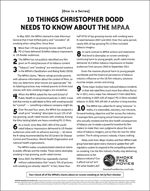10 things Christopher Dodd needs to know about the MPAA
Smoke Free Movies ran this ad in Variety today to help educate the new MPAA president, former US Senator Christopher Dodd, about whether he can trust what he haers from his staff on the MPAA's record on smoking in movies. The full ad is at http://www.smokefreemovies.ucsf.edu/ourads/ad_sfm81.htm
Smoke Free Movies has launched a series of print advertisements in Variety and other publications. This advertisement first ran in the September 27, 2011 edition of Variety and September 28, 2011 edition of The Hollywood Reporter.
10 things Christopher Dodd needs to know about the MPAA
In May 2007, the MPAA claimed to state Attorneys General that it had shifted policy and “considers” all smoking when rating films. Since then:
1) More than 170 top-grossing movies rated PG and PG-13 have delivered 30 billion tobacco impressions to US theater audiences.
2) The MPAA has not publicly identified any film given an R-rating because of its tobacco content.
3) “Tobacco” and “smoking” are mentioned nowhere in the MPAA’s Classification and Rating Rules (2010).
The MPAA claims, “Movie ratings provide parents with advance information about the content of films, so they can determine what movies are appropriate.” Yet its labeling practices may mislead parents to think most movies with toxic smoking imagery are smokefree:
4) When the MPAA asked the Harvard School of Public Health to recommend policies in 2007, it was told that merely to add labels to films with smoking would be “cynical” — something a tobacco company might do.
5) Over the past four years, the MPAA has assigned a small-print “smoking” descriptor to just 13% of all top-grossing, youth-rated movies with smoking. Among the films lacking labels are heavy-smoking PG-13 films.
6) As a result, since May 2007, 80% of the youth-rated tobacco impressions delivered to US theater audiences came with no advance warning — let alone the R-rating recommended by the US Centers for Disease Control and Prevention, World Health Organization and national health organizations.
The MPAA makes unsubstantiated statistical claims to public officials and the media. These claims downplay smoking in top-grossing, youth-rated movies:
7) Since 2007, the MPAA has repeatedly claimed without substantiation that “nearly 75% of pictures with smoking are already rated R.” In fact, fewer than
half (47%) of top-grossing movies with smoking were R-rated between 2007 and 2010. Over this same period, nearly 60% of top-grossing PG-13 films included tobacco imagery.
8) In stark contrast to MPAA actions and statements that tend to downplay on-screen smoking’s continuing harm to young people, youth-rated movies delivered 10.5 billion tobacco impressions to theater audiences from January 2010 to September 2011.
Given the massive physical harm to young people worldwide and the historical persistence of tobacco industry influence on the US film industry, solutions must be simple, certain and strong.
9) Three major studios have reduced tobacco incidentsin their kid-rated films much more than others. But sofar in 2011, every major has released 2-4 kid-rated films withsmoking. In 2007, 63% of majors’ PG-13 films included tobacco. In 2010, 40% still did. A solution is long overdue.
10) The MPAA has called the R-rating “extreme.” In reality, it is reasonable, voluntary, non-intrusive, forward-looking, objective and fair across the industry. It exempts films portraying actual historical persons who actually smoked and the dire health consequences of tobacco use. It creates a powerful incentive for film-makers to make their own judgments about the real value of tobacco imagery, just as they do now for other content. The R-rating censors nobody. It bans nothing.
Delay costs lives. Major studios and their MPAA trade group have been given every chance to update theirself-regulatory system to respond to the compelling evidence on smoking. Can the film industry finally stop delivering adolescents to the tobacco industry? Can it afford not to? Isn’t this what leaders do?
Smoke Free Movies
Smoking in movies kills in real life. Smoke Free Movie policies—the R-rating, certification of no payoffs, anti-tobacco spots, and an end to brand display—are endorsed by the World Health Organization, American Medical Association, AMA Alliance, American Academy of Pediatrics, American Heart Association, Legacy, American Lung Association, Americans for Nonsmokers’ Rights, American Public Health Association, Campaign for Tobacco-Free Kids, Los Angeles County Dept. of Health Services, New York State Dept. of Health, New York State PTA, and many others. Visit our web site or write: Smoke Free Movies, UCSF School of Medicine, San Francisco, CA 94143-1390.

